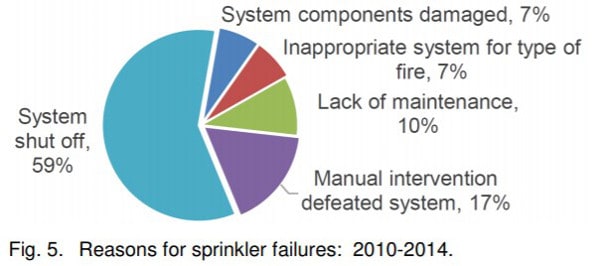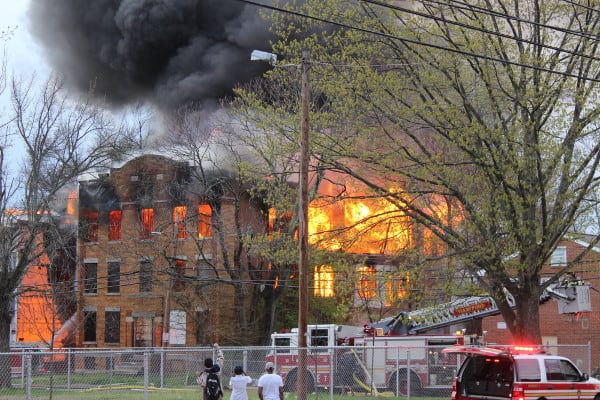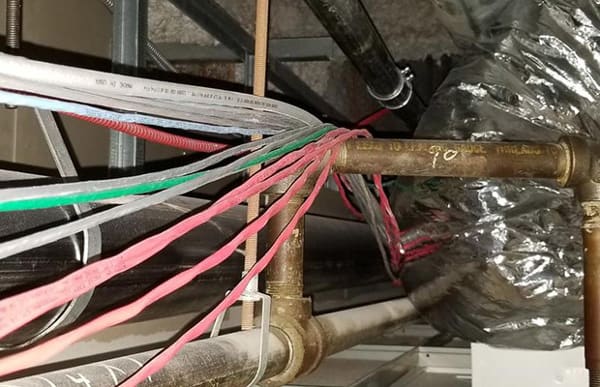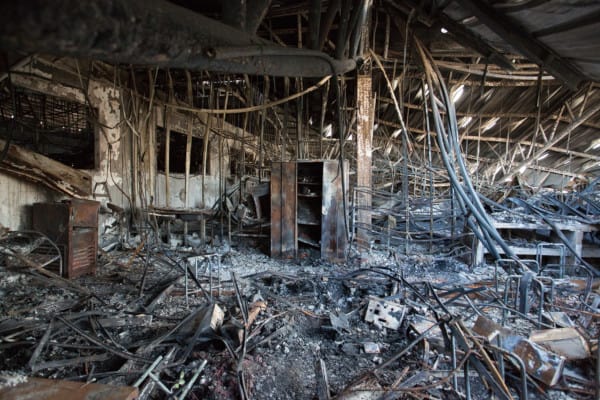People are the biggest threat to the effectiveness of fire sprinklers
Fire marshals’ and other fire protection inspectors’ “war stories” can be ironic—and frightening. Lawn and garden sprinklers mounted on the ceiling of a carport. Sprinkler pipes that collapsed because they were used to support cables and other items. Building staff shutting off activated sprinklers to avoid water damage—while the small fire they failed to notice spirals out of control. Burst pipes preventing sprinklers from working because the system wasn’t winterized properly.
Automatic fire sprinklers are a proven first line of defense when fires break out, controlling 96 percent of the blazes that trigger them. But the National Fire Protection Association (NFPA) reports that fire sprinklers fail or operate ineffectively 7 percent of the time—and more often than not, human error is to blame.
In this series, we shine a light on common mistakes that cause fire sprinkler failure, from simple-but-serious actions like shutting off the system to more complicated errors like installing systems that can’t control the intensity of fires generated by a property’s hazards.
In the market for fire protection? Feel free to browse our selection of fire sprinklers and accessories, including residential sprinkler heads, installation tools, shut-off tools that quickly stop triggered sprinkler heads, head guards that protect sprinklers from accidental damage or vandalism, and more.
Human error causes a whopping 93 percent of fire sprinkler failures
Before we dig in, let’s take a quick look at fire sprinkler system performance by the numbers. When installed properly, NFPA reports that fire sprinklers operate effectively in 92 percent of fires. When they fail, the chart below breaks down the biggest reasons why:

That means human error is responsible for a whopping 93 percent of fire sprinkler failures. Only 7 percent are caused by damage to system components. And even then, people still often play a factor, with damage occurring during shipping, installation, or accidental impacts in gymnasiums, warehouses, and other risky environments.
To learn how to safeguard sprinkler heads in impact-prone areas, check out our previous blog: “Heavy-Duty Fire Sprinkler Head Guards Protect Fire Sprinklers from Hard Hits.”
Robust requirements established by NFPA 13: Standard for the Installation of Sprinkler Systems and NFPA 25: Standard for the Inspection, Testing, and Maintenance of Water-Based Fire Protection Systems help avoid errors and ensure that fire sprinklers operate effectively when they’re needed most. But it’s human to make mistakes, and too often people aren’t aware of best practices for fire protection—or worse, flat-out ignore them.
Carelessness and oversights can lead to corrosion, obstructions, mechanical failures, and inadequate sprinkler coverage that leave people and property vulnerable. They can also spur code violations that impose hefty fines on property owners or complete building shutdowns.
Fixing mistakes can also be costly: repairing small leaks in sprinkler pipes costs an average of between $800 and $1,200, for instance, and replacing ruptured pipes averages between $6 and $8 per square foot. Clearly, it’s in a property owner’s or manager’s best interest to get things right the first time.
Here’s an extreme example of not doing this that involves sprinklers that aren’t connected to water pipes, screws and rocks lodged in system components, and sprinklers glued to the ceiling:
It doesn’t take mistakes as drastic as that alarmingly shoddy installation to prevent fire protection systems from doing their jobs. But the above video stands as a warning to property owners and facility managers to spot the kinds of errors that the fire marshal asserted could have led to “very dangerous” results.
Let’s examine some of the most common mistakes that can comprise sprinkler system performance:
Most fire sprinklers don’t work for the simplest reason: the system was shut off
Almost two-thirds of fire sprinkler failures—59 percent—happen because somebody simply turned the system off. Reasons vary: perhaps the building is vacant or under construction, or the system has been struggling with leaks or other emergency impairments and was shut down in preparation for a fix. Homeowners often shut off the water to their homes to avoid leaks while they’re on vacation and don’t necessarily consider that they’re also cutting the sprinkler system’s water supply.
But here’s the thing: vacant buildings still pose a hazard to adjacent structures and firefighters, with the potential for fires to spiral out of control as they spread unhindered and unnoticed. NFPA 1: Fire Code requires all fire protection systems in vacant or seasonal buildings to be kept in service unless otherwise approved by the authority having jurisdiction (AHJ). That directive also extends to the maintenance of associated water flow and supervisory alarm systems that ensure that sprinklers are monitored properly, and alarms will transmit as needed.
When sprinklers are out of service, the potential increases for damage or vandalism that’s hard to detect—especially in unoccupied buildings. For that reason, the AHJ can require an inspection and test of any fire protection system that’s been turned off for 30 days before it’s returned to service.

Even if the system is temporarily turned off to fix impairments like frozen pipes, equipment failures, or water supply interruptions, NFPA 25 attempts to minimize the length of time that sprinklers are out of service with detailed requirements for shutdowns that extend longer than 10 hours.
These mandates can include a fire watch, where trained personnel continuously patrol an affected area, watching for flames and ensuring that the building’s other fire protection features like egress routes and alarm systems are available. Businesses may also be required to cut off the flow of fuel to certain machines, institute a strict “no smoking” policy, and halt work that can start fires until sprinklers are back on, such as cutting, grinding, or welding. The following covers only some of the measures necessary for managing a “preplanned impairment:”
From the 2023 edition of NFPA 25
15.5.2 Before authorization is given, the impairment coordinator shall be responsible for verifying that the following procedures have been implemented: […]
(4) Where a fire protection system is out of service for more than 10 hours in a 24-hour period, the impairment coordinator shall arrange for one of the following:
(a) Evacuation of the building or portion of the building affected by the system out of service
(b)* An approved fire watch
(c)* Establishment of a temporary water supply
(d)* Establishment and implementation of an approved program to eliminate potential ignition sources and limit the amount of fuel available to the fire
NFPA 25 also details the steps that must be followed by qualified personnel or contractors before systems and valves can be returned to service after repairs. Generally, that includes checking for closed valves, corroded pipes, damaged sprinklers, missing hangers, and insufficient supports. It also usually involves air tests before sprinkler systems are filled with water, a full hydrostatic test if extensive damage had to be repaired, operating control valves through their full range of motion to ensure adequate water flow, and testing water supply equipment like fire pumps.
From the 2023 edition of NFPA 25
15.7 Restoring Systems to Service. When all impaired equipment is restored to normal working order, the impairment coordinator shall verify that the following procedures have been implemented:
(1) Any necessary inspections and tests have been conducted to verify that affected systems are operational. The appropriate chapter of this standard shall be consulted for guidance on the type of inspection and test required.
(2) Supervisors have been advised that protection is restored.
(3) The fire department has been advised that protection is restored.
(4) The property owner or designated representative, insurance carrier, alarm company, and other authorities having jurisdiction have been advised that protection is restored.
(5) The impairment tag has been removed.
Even when everything is working right, manual interference can cause fire sprinkler failure
In nearly 20 percent of system failures, fire sprinklers are “defeated” by “manual interventions.” For example, over-eager building staff—or occasionally, firefighters—may turn the system off because a fire isn’t immediately apparent, or they believe it’s already out.
Of course, this action enables a tiny blaze to grow, making it more likely that even if the sprinklers are turned back on, they will be overwhelmed by the fire. Training on-site workers on what precautions to take in abnormal conditions—and what specific situations justify shutting sprinklers off—is an important part of maintaining a fire protection system’s operational status.
Placing obstructions in a sprinkler head’s path is another manual intervention that stops fire sprinklers from deploying. Usually the result of careless maintenance or design, obstructions can take the form of bulkheads, structural components, vertical office divisions, piping, ducts, light fixtures, boxes, or refuse or storage that’s piled high. These objects can prevent the fire’s heat from activating the sprinkler, block water from reaching a fire, or otherwise stop the sprinkler’s discharge pattern from developing properly.
In many cases, sprinkler systems are designed based on an empty layout of the rooms they will protect. Opening the lines of communication between fire protection system designers, architects, and interior designers during the design phase can help optimize sprinkler coverage while accounting for obstacles that aren’t apparent in blueprints.
Many schools and public buildings are guilty of hanging banners and other decorations from sprinkler heads and pipes. In hotels and residential buildings, people may turn them into clothes hangers. In some instances, people overestimate sprinkler pipes’ strength and use them to support other building components like wires, lighting, and ductwork—or even worse, to lift heavy objects.

Here’s why that’s a dangerous practice: sprinkler piping and hangers are only designed to support the static and load that are part of the sprinkler system. Forcing them to bear additional weight can lead to failures—especially as water adds more stress by coursing through the pipes.
Draping flammable items such as cables across sprinkler pipes can also compromise systems. Bundles of cable can burn violently enough to melt sprinkler piping and supports, rendering them inoperable during a fire. Repainting and renovations may impair sprinklers with paint or spackle as well, and dust and grease can clog heads if cleaning is neglected.
Disregarding manufacturer instructions or installation standards is another way people interfere with fire protection systems. For instance, there’s a misconception that the higher sprinklers are placed, the better protection they provide.
In reality, wall sprinklers are designed for a specific mounting height that takes their spray pattern into account. Ignoring the recommended height and installing them too close to the ceiling will disrupt the pattern and prevent the sprinkler from performing as expected. Placing sprinkler heads too close to objects that generate heat like skylights or heaters is another common mistake, potentially causing sprinklers to activate when there’s no fire in sight.
Watch this video to discover one more thing that shouldn’t hang from fire sprinkler pipes: people. You would think that would go without saying:
We’re not done yet—stick around for more mistakes that compromise fire sprinkler systems
With apologies to the English poet Alexander Pope: “To err is human; to fix or avoid fire sprinkler mistakes before they endanger people and property is divine.”
Be sure to check out part 2 of this series, where we examine more common mistakes, including the installation of the wrong fire sprinkler system or the failure to revise one based on what the building is used for; and the potentially catastrophic results of ignoring the inspection, testing, and maintenance (ITM) requirements in NFPA 25.
In the market for fire protection equipment? Feel free to browse our selection of fire sprinklers and accessories, including residential sprinkler heads, installation tools, shut-off tools that quickly stop triggered sprinkler heads, head guards that protect sprinklers from accidental damage or vandalism, and more.
Questions about QRFS products or need a brand or item that’s not in our online inventory? Just call us at +1 (888) 361-6662 or email support@qrfs.com.
This blog was originally posted at blog.qrfs.com. If this article helped you understand fire sprinkler riser rooms, check us out at Facebook.com/QuickResponseFireSupply or on Twitter @QuickResponseFS.



It’s good to know that most sprinkler failures are the product of someone turning the system off. My wife and I want to make sure that our sprinklers are functioning properly. We’ll be sure to have a professional ensure that our system isn’t turned off in the future.
Great article, very insightful and well-written article. People are definitely the #1 issue!
Thank you!
Thank you for highlighting just how flaky and unreliable sprinkler systems are. I certainly won’t be relying on one to save my life! Much better to ensure that the building design is safe enough without them.
Paul — We’re not sure why you came to the conclusion that sprinklers systems are “flaky and unreliable.” It’s the opposite. From the piece: “Automatic fire sprinklers are a proven first line of defense when fires break out, controlling 96 percent of the blazes that trigger them.” Since this piece was written, NFPA research has shown that the numbers have gotten slightly better: “From 2017 to 2021, sprinklers operated in 92 percent of such fires and were effective at controlling the fire in 97 percent of the incidents.” In the few cases where sprinklers did not activate during a fire, it was because someone shut them off (which can be prevented with simple measures, like locking or monitoring control valves). Thus, sprinkler systems are very reliable. In addition, no other aspect of building design exists to actively control fires, 24/7, often putting them out before firefighters arrive. Thanks for reading!